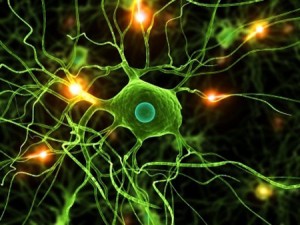Low Dose Electrical Current Boosts Creativity
 Our thinking and decision-making is strongly shaped by what has worked in the past. Success is compiled into rules and mental sets that make us more efficient but also blind us to innovative alternatives. If we could safely disrupt the applications of mental sets at the right time we might enhance our creativity. That idea was recently tested using transcranial direct current stimulation (tDCS) by researchers at the Center for the Mind.
Our thinking and decision-making is strongly shaped by what has worked in the past. Success is compiled into rules and mental sets that make us more efficient but also blind us to innovative alternatives. If we could safely disrupt the applications of mental sets at the right time we might enhance our creativity. That idea was recently tested using transcranial direct current stimulation (tDCS) by researchers at the Center for the Mind.
The experiment involved 60 subjects that were given a creative problem to solve. Some received a small electrical current applied to their brain in a region thought to hold mental sets that guide our problem solving. The results were dramatic:
“Only 20% of participants solved an insight problem with sham stimulation (control), whereas 3 times as many participants did so…”
A strong effect but one that needs to be repeated and further explained using brain scanning studies.
Only a tiny amount of electrical current is being used in tDCS. It has been the focus of other studies designed to enhance cognitive performance. We covered one from Oxford University in an earlier post on the Next Brain Blog.
I am interested to hear from readers about how low-level direct current is being used to stimulate cognitive performance.
Categories: Other, Problem Solving Tags: cognitive bias, experiential learning, tDCS
Avoid Falling into These Common Decision Traps
Life is made up of a handful of critical decisions, hundreds of important decisions and literally thousands of minor decisions. Taking the time to develop good decision-making skills is well worth the investment. We will cover the topic regularly in the Next Brain Blog.
One proven way to enhance your decision-making skill is to actively manage the traps (also known as cognitive biases) that we can fall into. The Hidden Traps in Decision Making is an easy-to-read primer filled with practical advice. The traps or cognitive biases it covers include, for example:
- ANCHORING: Overemphasizing the first information you recieve
- STATUS QUO: Selecting alternatives that best fit what you are currently doing
- SUNK COST: Making decisions that support past decisions
- CONFIRMING EVIDENCE: Seeking and accepting information that supports your current or preferred point of view.
 We all have these tendencies. They cannot be eliminated, they are part of how our brain works. We have them because they provide strong advantages in certain circumstances. The key is to be aware of them and take simple steps to make sure they don’t trap us into making poor decisions. For example, one way to avoid the confirming evidence trap is to be sure you always find an equal amount of evidence for and against your prevailing point of view. Or ask another to scout the opposing evidence that you might be biased against seeing as relevant.
We all have these tendencies. They cannot be eliminated, they are part of how our brain works. We have them because they provide strong advantages in certain circumstances. The key is to be aware of them and take simple steps to make sure they don’t trap us into making poor decisions. For example, one way to avoid the confirming evidence trap is to be sure you always find an equal amount of evidence for and against your prevailing point of view. Or ask another to scout the opposing evidence that you might be biased against seeing as relevant.
Turns out we are loaded with dozens of biases that impact how we learn, perceive the world, make decisions, socially interact and perform other cognition-intense tasks. There will be a lot to blog about. Look forward to comments on how you have learned to manage decision-making or other types of cognitive biases.
Categories: Decision Making, Training Tags: cognitive bias
